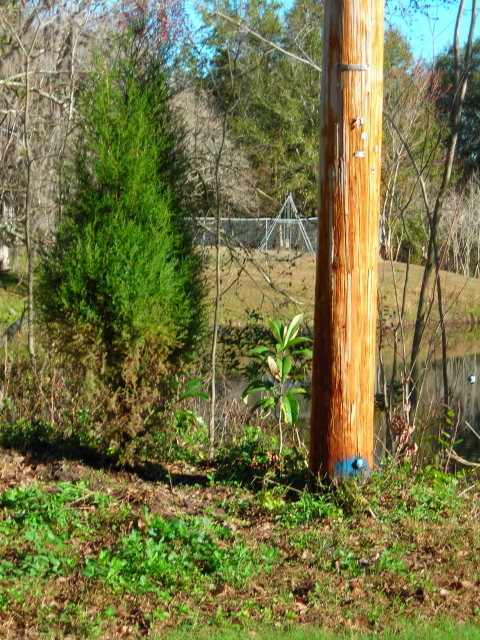Question cedar 1
cedar 1
QUESTION: A small cedar was planted as part of our pond restoration. It has grown
beautifully for a little over two years with no problem. Now it seems to be
dying from the bottom up? It has been dry but the drought rating is
"normal". We think it is planted to close to the telephone pole and electric
lines above so want to move it.
1. Can we save it.
2. Can we move it safely now or ever?
I have 2 close up shots I will send.
Thank you.
ANSWER: Looks as if something was sprayed at ground level and killed back the lower foliage. Besides that it looks healthy and can be moved and should be.
Moving it will depend on where you live and if the ground freezes there. If not now is the time to move the tree.
Evergreens should be moved earlier in the fall than deciduous plants so they have time to form new roots. They need at least 6 weeks before the ground freezes. In the spring, Evergreens can be planted up to 4 weeks after deciduous trees have opened their leaves, providing that the newly planted trees receive adequate water.
Digging the root ball:
When you want to dig up a tree or shrub for transplanting, retain as much of the root system as possible. Evergreens can be successfully moved only if a ball of soil is left around the roots. The exposed roots should be protected with moist burlap or newspaper or with polyethylene sheeting. Every effort should be made to reduce root exposure to wind and sun, keeping the ball as moist as possible. It's best to prepare the hole before digging up the tree you wish to move.
Size of the root ball and size of the hole:
For trees the soil ball should be:
Width = 9-12 in. in diameter/every 1 in. of tree diameter
Depth = 6 in./every 1 in. of tree diameter
For example: A tree trunk 2 inches wide would need a soil ball of 18-24 inches wide and 12 inches deep.
Dig the new hole twice the size of the rootball and as deep and fill with good top soil. Mulch around the tree with not more than 3 inches deep of organic mulch not piled up on the trunk. Pine straw is good. Do not fertilize the tree for a year after transplanting.
---------- FOLLOW-UP ----------
QUESTION: The puzzlement included in my thank you follow up was poorly worded.
Could there be anything else causing the browning besides spray?
-The area that is turning brown keeps increasing.
-Its hard to imagine that there has been any spraying near this tree. We
are restoring the pond to a healthy natural state so we use no sprays or
fertilizers.
-The tree is about 5 feet from a moderately used road that was repaved this
spring but we have lots of other plantings along that strip and nothing else is
showing damage.
Any more ideas?
Thanks again.
AnswerWhat I saw on your picture was the lower foliage was effected. I do not know of a foliage disease or insect that would effect just the lower crown near the ground. That is why I leaned toward something environmental or a spray. Other things could be a dog using the tree or the Power Co. has sprayed around the pole for plant control. In these cases if you move the tree I would not think you would have a problem. Sorry I mis-read your thank you. -






